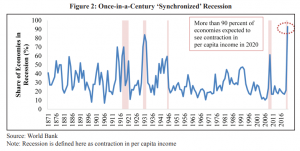
India’s unemployment rate touched a four-month high of 7.91% in December 2021, according to the latest CMIE data. The decline was evident even before the latest Covid-19 restrictions in several states. The unemployment rate stood at 7% in November 2021 and 9.1% in December 2020. Urban unemployment rose to 9.3% in December while rural employment stood at 7.28%. The urban unemployment rate rose from 8.2% in November, while the rural unemployment rate increased from 6.4%.
The urban unemployment rate on a weekly level spiked to double digits to 10.09% in mid-December. Urban employment is an indicator for better-paying jobs and a decline in these numbers imply an adverse impact on the organised sector.
READ I An unkept promise: What derailed the Indian Economy
With the number of Covid-19 cases increasing and the Omicron threat looming, many states have imposed restrictions. These restrictions have affected economic activity, and livelihood opportunities, particularly in the informal sector, are taking a hit. This will subsequently add to the prevailing unemployment woes. A substantial increase in unemployment in December can be attributed to muted economic activity caused by the rising number of Covid-19 cases across the world.
Covid-19 and unemployment crisis
India was experiencing a decline in employment even before the Covid-19 pandemic broke out. The trend started in 2016 and the unemployment rate reached a 45-year-high in 2019 before the onset of Covid-19. Thereafter, the pandemic-induced lockdown and a series of partial lockdowns led to deterioration in the employment situation. There was some recovery during the last quarter of 2020-21, but the situation worsened due to the severe second wave of the pandemic. The economy is still reeling from the Covid-19 onslaught.
Many countries experienced high levels of unemployment in 2020. However, India’s unemployment rate exceeded that of other emerging economies such as Bangladesh (5.3%), Mexico (4.7%), and Vietnam (2.3%). Even organised sector jobs were adversely affected. A number of studies indicate that young workers (15 to 23 years old) were hit the hardest during the pandemic-induced lockdown in 2020 as the organised sector took the opportunity to rationalise the workforce.

The employment elasticity of manufacturing activities was abysmally low and most workers who left agriculture could only be absorbed in the urban informal sector. Even during the period when economic growth was relatively decent, employment growth was only moderate. Some economists categorised this phenomenon in the second half of the previous decade as jobless growth.
READ I Budget 2022 must invest in monitoring education, health schemes
The situation became precarious in the sense that even labour force participation rate has fallen in recent times. In other words, those who are employed and the number of active job seekers in the working-age population have fallen. The female labour force participation rate is among the lowest in the world. The unemployment rate is higher among the educated sections that are economically better-off. This section may wait for better opportunities to emerge whereas the poorer sections may get engaged in petty economic activities on their own just to subsist.
Three-quarters of India’s workforce is self-employed and casual. They do not enjoy any legislative protection and lack access to institutional social security. Only a little over 2% of the workforce have secure formal jobs with access to institutional social security in the form of provident fund, medical assistance, maternity benefits, gratuity, and pension. A paltry 9% have formal jobs with access to at least one social security instrument.
Around 90% of the workforce are in low-paying informal jobs. They work, but still remain poor. They are referred to as the ‘working poor’. They earn less than Rs 9,750 ($130; £96) a month (https://www.epw.in/engage/article/protection-workers-wages-india-labour-wage-code). That is less than Rs 375 a day, the minimum wage proposed in 2019 by the Satpathy Committee.
READ I Budget 2022 must focus on demand, jobs, reforms
The informal economy in India provides a livelihood to more than 90% of the total workforce. In terms of non-agricultural employment, the share of informal employment in India is 83.6%. There has been a growing use of contract and casual labour in the formal sector over time. For example, the wage gap between contract and regular workers in the organised manufacturing sector was 25% in 2013-14. This explains the dramatic rise in the proportion of contract workers in the sector from 12% in 1990-91 to 33.6% in 2013-14.
Over the last three decades, India’s occupational distribution could not keep up pace with changes in the sectoral distribution of national income. Over the years, contribution of the primary sector in the national income declined steadily (presently its share is 14.2%) but it still engages an overwhelmingly large number of workers. The number of workers engaged in the primary sector did fall but not to the level it was expected to. The share of workers engaged in the primary sector fell from 52.45% in 2009 to 42.39% in 2018-19.
The corresponding increase in secondary sector employment was from 21.18% in 2009 to 25.58% in 2019. Many workers continued in the primary sector as additional hands and the rest left the primary sector to look for livelihood in the secondary and tertiary sector in urban areas. The majority of such workers found ways of survival in urban areas as informal workers in the secondary sector and tertiary sector.These informal manufacturing and service sector workers often eke out a livelihood by engaging themselves as appendage workers of the formal sector and through various extension and non-core activities, petty economic and subsistence activities on the fringe like selling vegetables on the roadside, opening cycle-repairing shops, hawking on the roadside, working in public transport and domestic work.
As per the periodic labour force survey 2017-18, 52% of informal workers are self-employed and survive through precarious activities. The majority of such workers are unskilled or at best low-skilled. This vulnerable section of the workforce was hit hard in the Covid-19 induced economic dislocation.
The latest unemployment figures clearly bring forth the employment crisis faced by the country. Economic recovery, as and when it happens, must take care of this situation and find ways of creating decent, meaningful livelihood opportunities. The nation desperately awaits some effective policy intervention from Finance Minister Nirmala Sitharaman in Budget 2022 and beyond.
(Dr Kingshuk Sarkar is an independent researcher. He worked as a labour administrator and is presently a visiting faculty at the Goa Institute of Management. The views are personal.)
Dr Kingshuk Sarkar is an associate professor at the Goa Institute of Management. He has worked as a labour administrator with the government of West Bengal. He earlier served as a faculty member at VV Giri National Labour Institute, Noida and NIRD, Hyderabad. Views expressed are personal.


